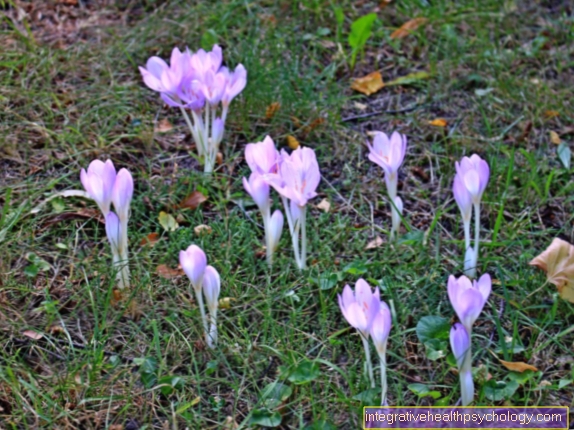Mediastinitis
synonym
Inflammation of the median membrane space
definition

The mediastinitis comes as acute and as chronic form in front. Acute mediastinitis is a very dangerous one Inflammation of the median membrane space in which, among other things, the heart lies. It can be caused by various pathologies such as a Leak in the Esophagus arise. It goes hand in hand with a severe feeling of illness and requires quick action, otherwise it life threatening can be. If left untreated, acute mediastinitis is fatal in almost 100% of cases. Chronic mediastinitis tends to be insidious and the available therapeutic measures are limited.
Anatomy / physiology
The Mediastinum, also Middle skin called, lies between the left and the right Lung which each of the Pleura (Pleura) is wrapped. At the top, the middle area joins the neck area, and at the bottom it ends at the diaphragm. The mediastinum extends from the back to the front of the spine Sternum (sternum). The mediastinum is divided into an upper and a lower. This is where all the organs of the chest are located with the exception of the lungs. In addition, numerous vessels and nerves run through the middle layer. In the upper mediastinum lie the thymus, the lower part of the windpipe (Trachea), and the esophagus (Esophagus). In addition, numerous vessels run along here, including part of the main artery (aorta) and part of the vena cava (Vena cava). Nerves, for example the 10th cranial nerve (Vagus nerve), and lymph channels run through the upper mediastinum. In the lower mediastinum lie the heart and the esophagus as well as numerous vessels and nerves.
causes
A distinction is made between an inflammation of the middle layer acute and one chronic form. Acute mediastinitis is usually the trigger bacteria. Various causes can cause bacteria to enter the mediastinum. For example a more inflamed tooth, inflamed tonsils (popularly known as tonsillitis) or a Abscess in the head / neck area. The pathogens can then spread along anatomical structures from their actual seat to the mediastinum. Can also be a Pathogen spread within the framework of a lung infection (pneumonia) or one Inflammation of the pericardium (Pericarditis) Be a trigger for mediastinitis. Another cause of a bacterial colonization of the middle area can be a Hole in the esophagus be. This can, for example, in the context of the so-called Boerhaave syndrome occur, this leads to a tear (rupture) of the esophagus due to massive vomiting. People who suffer from Boerhaave syndrome often have a history of chronic alcohol abuse. However, Boerhaave syndrome is a very rare condition.
More frequent - but far from common - causes of a leak in the esophagus are the ingestion of caustic substances or medical interventions. For example, a hole in the esophagus under a Gastroscopy (Gastroscopy) or Intubation (Insertion of a tube into the windpipe for artificial ventilation). Overall, however, such perforations of the esophagus rarely occur. If a perforation now occurs, numerous bacteria emerge from the esophagus into the middle layer and cause a fulminant inflammation within a very short time. Another cause of a mediastinis are surgical interventions in the cardiovascular area. During an operation, the greatest value is placed on sterile - i.e., bacteria-free - work, but it does not succeed in 100% of the cases. Less often one can Rupture of the windpipe (Trachea) occur, for example, as part of a reflection of the upper airways (bronchoscopy). But even in traffic accidents with the action of strong forces, organs such as the windpipe or bronchi can rupture in rare cases.
A chronic mediastinits differs significantly from the acute form in terms of the causes as well as the symptoms and therapeutic measures. The chronic form can mainly occur when a weakened immune system present. As part of this weakening, for example, the middeal space can be infected with fungi. These include Aspergillus flavus and Cryptococcus neoformans. A chronic mediastinit can also be used in the context of chronic diseases such as the Consumption (Tuberculosis) or after radiation therapy in cancer patients.
Symptoms
The symptoms of acute mediastinitis can be very pronounced and impressive. This is also due to the fact that the symptoms of the triggering event are often in the foreground at first. So, patients with a ruptured esophagus often have it severe chest pain, Patients with a ruptured windpipe usually suffer suddenly acute shortness of breath. Symptoms of middle skin inflammation in and of themselves are usually a clear one Feeling sick with exhaustion, Fever, fast heartbeat (Tachycardia) and if applicable Pain behind the sternum. In the chronic form, the symptoms develop more slowly. The chronic inflammatory stimulus leads to an increase in the connective tissue in the mediastinum, this process is known as Fibrosis. This can lead to a narrowing of the esophagus and trachea so that the patient often overcomes shortness of breath (Dyspnea) or Difficulty swallowing (Dysphagia) complain. It can also be used for Compression of vessels come. If the superior vena cava, which carries the blood from the periphery to the heart, is compressed, this can lead to a congestion of the blood in front of the heart. If the superior vena cava (vena cava superior) is affected, this is called an upper congestion. She can get through a headache or one increasing pressure in the head to make noticable.
Diagnosis
If mediastinitis is suspected, the anamnese and the physical examination provide important information. You can ask about recent operations here, and the Collection of symptoms an important role. For example, sudden severe chest pain after previous excessive vomiting can be a decisive indication of the rare Boerhaave syndrome be. Sudden shortness of breath after a bronchoscopy may indicate a rupture of the windpipe. If chronic mediastinitis is suspected, it is important to ascertain previous illnesses. The physical exam may include a Cutaneous emphysema be keyed. This is a build-up of air under the skin that causes a crackling sound and sensation when pressure is applied to the affected area. Such skin emphysema can occur when air-containing organs such as the windpipe or the esophagus rupture and air escapes from the organ into the mediastinum and from there towards the skin. The diagnostic measure to secure the diagnosis is an imaging of the thorax (chest cavity). Usually an X-ray is taken. If this is not sufficient, it may also be necessary to produce a computed tomographic image (CT).
therapy
Therapy of acute mediastinitis depends on the triggering event. If a hollow organ such as the esophagus or the windpipe ruptures, a surgical closure of the defect respectively. Depending on the type and severity of the mediastinitis, surgical relief must be performed in order to ensure that the pathogen-containing secretions in the mediastinum can drain. This can be done by Insertion of a small tube (drainage), which ensures an outflow of the liquid to the outside. If necessary, however, an operative opening of the mediastinal space must be carried out in order to reach the drain. In any case, a high-dose intravenous (via the vein) Antibiotic therapy respectively. Chronic mediastinitis is difficult to treat. If fungal infections are the trigger, drugs that work against fungi (Antifungal drugs) are used, mediastinitis caused by tuberculosis (consumption), drugs against the tuberculosis pathogens (Tuberculostatics) can be used. Otherwise you can try Corticosteroids be undertaken, these are drugs that are able to curb the inflammatory process and the connective tissue remodeling (fibrosis) to some extent.
forecast
The lethality of acute mediastinitis is almost 100% in the absence of adequate therapy. Even with therapy, deaths are not uncommon. The particular danger lies in the development of a so-called sepsis (colloquially referred to as blood poisoning) due to the spreading of the causative pathogens through the blood. However, adequate therapy can significantly reduce the death rate.
Additional information
Also read:
- lung infection
- tuberculosis
- fever





























